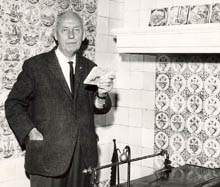The Tiles Collection > About the collection

For centuries, tiles had been produced as practical and decorative building materials and not uncommonly reused as such. By the end of the nineteenth and the beginning of the twentieth centuries, collectors started to become interested in tiles as building ornaments. As old city centers were renovated in the early 1900s, large numbers of antique wall tiles became available. Architects, draftsmen and contractors established a number of early, substantial collections.
While working on a restoration in the early 1950s, the architect Gerrit Feenstra (1890-1985) from the city of Arnhem noticed that many old wall tiles were being exported. He therefore decided to establish a historically representative collection himself. In 1961, he opened his museum in a number of rooms in the It Noflik Sté house in Otterlo, which he had designed. In 1967, the Stichting Nederlands Tegelmuseum (Netherlands Tiles Museum Foundation) was set up to manage the house and the collection, which had grown considerably. Compared to earlier collections, the Feenstra collection focuses more on eighteenth and nineteenth century tiles and tableaus. It also includes work by contemporary ceramists, however.
The art teacher Jan Dingeman Korf (1906-1982), a contemporary of Feenstra, was the first to draw up a classification system for the subjects featured on the tiles. His publications on tiles and majolica were reprinted many times: they were, and still are, a guide for generations of collectors. In 1998, the Dingeman Korf collection was given on long-term loan to the Netherlands Tiles Museum.
A year later, the museum received a bequest from Hans E. Muller, a collector who had worked for Christie's as a valuer. And in 2004, another bequest followed: the tiles from Mrs. M.F.M. Manschot-van der Meij's (1912-2004) private collection, including many very rare ones.
The collection was expanded substantially starting in the 1970s with tiles from the years 1890-1940, a period during which De Nieuwe Kunst (Art Nouveau) made its entry in the Netherlands. New industrial techniques and their large-scale application in the manufacturing of tiles led to a renaissance of the industry in the Netherlands. Many major buildings dating back to that period were demolished or thoroughly renovated within a couple of generations at a time when architectural ornaments had gone out of fashion. Examples are the impressive Kareol villa in Aerdenhout (built in 1906/08, demolished in 1980), with tableaus by Max Laeuger, and the De Liefde (The love) Roman Catholic Church in Amsterdam (built in 1882, demolished in 1990), with tableaus based on designs by the great Dutch architect Pierre Cuypers.
